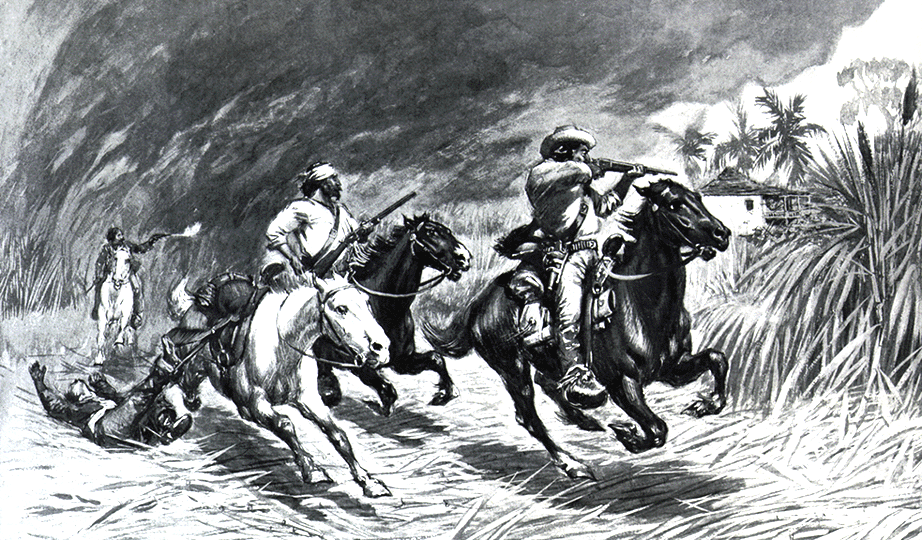

Chronology
of the "Cuban Independence War" more
commonly known as the"Spanish American War"
where Orestes Ferrara fought and became a Colonel of the Cuban Liberation Army.
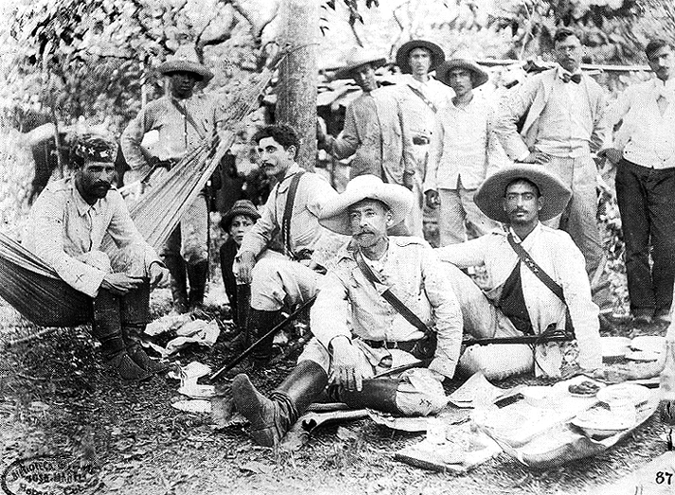 |
|
| 1895 |
1895
|
| February 24 | Cuban
insurgents raise against the Spanish Colony in Oriente, Santa Clara
and Matanzas provinces in what became known as "Grito de Baire."
|
|
|
|
| March 4 | Spanish
Coloney Govemor-General proclaimes martial law in Santiago and Matanzas.
Julio Sanguily, J Aguirre and other suspected Cuban sympathizers arrested
and incarcerated in Cabañas prison at Havana.
|
| March 8 | American
mail steamship Alliance fired upon by Spanish gunboat.
|
| March l0 | First
battle of the war at Los Negros between l,000 Spanish, under General
Garrich, and 700 Cubans, under Colonel Goulet. Spaniards defeated.
Spanish reinforcements arrive from Puerto Rico and 7,000 men from
Spain. Spanish Colony Field Marshal Arsenio Martínez Campos
appointed Captain-General to succeed Calleja, and sent to Cuba with
20,000 troops. Martial law proclaimed over whole island.
|
| March 24 | Pitched
battle at Jaraguana between l,000 Spanish Colony troops, under Colonel
Araoz, and 900 Cubans, under Amador Guerra.
|
| March 31 | Antonio
Maceo, with Flor Crombet, Dr. Frank Agrarnonte, Jose Maceo and other
officers, landed at Baracoa with expedition from Costa Rica in British
schooner Honor. Schooner wrecked and captain killed by Spaniards. Latter
attacked Maceo at Duaba but were repulsed. Agramonte captured. Provisional
government proclaimed by General Antonio Maceo; Dr. Tomás Estrada
Palma, president, José Martí, secretary-general, and
General Máximo Gómez, military director and commander-in-chief.
|
| April 13 | General
Máximo Gómez, José Martí and eight companions
arrived from Haiti and landed on the coast southwest of Cape Maisi.
|
| April 16 | Captain-General
Martinez Campos landed with reinforcements at Guantanamo and issued
proclamation pledging reforms. Spanish parliament authorized government
to raise 600,000,000 pesetas ($120,000,000) for war and decided to
send 40,000 reinforcements.
|
| April 16-18 | Battles
at and near Sabana de Jaibo. Cuban cavalry under Gomez defeated Colonel
Bosch.
|
| April
21 |
Battle
of Ramón de las Jaguas, 100 Spaniards killed.
|
| April 29 | José Maceo ambuscaded 700 Spaniards at Arroyo Hondo; 150 Spaniards killed
and
heavy Cuban losses
|
| May 6-14 | Raids
and fights at Jobito and Cristo by Maceo; Spanish Lieutenant-Colonel
Bosch killed.
|
| May 18 | Insurgent
Convention elected Bartolomé Massó president, Máximo
Gómez general-in-chief, and Antonio Maceo commander-in-chief
of the Oriental Division.
|
| May 19 | José Martí and
party of 50 annihilated by colonel Ximenez Sandoval and 800 troops
in a narrow pass; Gómez with reinforcements attempted to rescue
Martí's body and was wounded; Cuban loss, 50 killed and l00
wounded. Dr. Tomás Estrada Palma elected to succeed Martí as
Cuban Revolutionary Party delegate in the United States.
|
| May 20 | Colonel
Lacret and Colonel Torres landed with filibustering expedition of 220
men from Jamaica.
|
| June 2 | General
Maximo Gomez crossed trocha and entered province of Puerto Principe.
|
| June 5 | General
Carlos Roloff's filibustering expedition, with 353 men, 1,000 rifles
and 500 pounds of dynamite, landed by tugboat George W. Childs near
Sagua Lachico, in Santa Clara.
|
| June 12 | President
Cleveland issued proclamation warning citizens against joining or aiding
filibustering expeditions
|
| June 18 | Province
of Puerto Principe declared in a state of siege.
|
| June 27 | Spanish
Colony Captain-General Campos asked Cabinet for 14,000 fresh troops.
|
| July 1 | Campos
established Moron-Jucaro trocha to keep General Maximo Gómez
out of Santa Clara Province
|
| July 13 | Captain-General
Campos, at head of 1,500 troops, attacked but defeated by Cubans under
General Antonio Maceo at Peralejo and compelled to retreat to Bayamo;
Spanish General Santocildes and 119 men killed; Cuban loss, l00 men.
|
| July 15 | Cuban
Provisional Government formally constituted and a declaration of independence
proclaimed.
|
| August 7 | Cuban
Convention at Puerto Principe elected the following officers: Provisional
President of the Republic of Cuba, General Bartolomé Massó,
Minister of the Interior Marquis of Santa Lucia; Vice-President and
Minister of War, General Máximo Gómez, Secretary of Foreign
Affairs, Gonzalo de Quesada; General-in-Chief, General Antonio Maceo.
|
| August 31 | Spaniards
defeated by 1,000 men under José Maceo, near Ramon de la Jaguas
|
| September 23 | Constitution
of Cuban Republic proclaimed by Congress of Delegates at Anton de Puerto
Principe, and the following elected permanent officers of the government:
President, Salvador Cisneros; Vice-President, Bartolomé Massó;
Secretary of War, Carlos Roloff; Commander-in-Chief, Máximo
Gómez, Lieutenant-General, Antonio Maceo.
|
| October 2 | General
Antonio Maceo defeated superior force of 2,000 Spaniards at Mount Mogote.
|
| October 9 | Cuban
loan of 15,000,000 pesos ($3,000,000) placed in Paris
|
| October l0 | Baracoa
captured by Cubans
|
| October 27 | General
Carlos Miguel. de Cespedes landed near Baracoa with filibustering
expedition of sixty men, l00 rifles and l0,000 rounds of ammunition,
fitted out in Canada. Laurada seized at Charleston, South Carolina,
as a filibuster.
|
| November 18-l9 | Spanish
forces under Generals Valdes, Luque and Aldave defeated at Taguasco,
Spanish loss, 500
|
| December 26 | General
Maximo Gómez invaded the loyal Province of Havana.
|
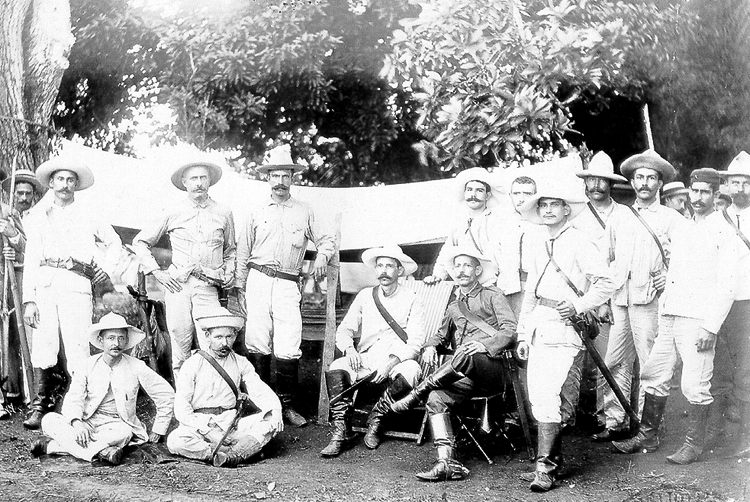 |
|
| 1896 |
1896
|
| January 5 | General
Maximo Gómez passes the Havana-Batabanó trocha into Pinar
del Rio.
|
| January 12 | General
Maximo Gomez defeated Spaniards at Batallobo and recrossed trocha into
Havana Province
|
| January 12-20 | General
Antonio Maceo raided Pinar del Rio Province.
|
| January 17 | Spanish
Colony Captain-General Canupos recalled to Madrid and General Valeriano
Weyler appointed to succeed him.
|
| January 26 | Filibuster
J. W. Hawkins, carrying General Calixto García and 120 men,
sunk off Long Island and ten men drowned.
|
| January 30 | General
Antonio Maceo recrossed Habana-Batabanó trocha; Spaniards severely
defeated by Diaz near Artemisa.
|
| February 10 | General
Weyler arrived at Havana on the cruiser Alfonso XIII and was enthusiastically
greeted.
|
| February 17 | General
Weyler issued three proclamations establishing rigid martial law.
|
| February 18 | General
Antonio Maceo attacked and captured Jaruco; the next day he joined
General Maximo Gómez, and together they marched eastward.
|
| February 22 | Eighteen
non-combatants killed by Spanish troops in Punta Brava and Guatao,
and two American correspondents who investigated outrage arrested.
|
| February 24 | Filibuster
Bermuda seized by United States marshals, General García and
others arrested, tried and acquitted.
|
| February 28 | US
Senate adopted belligerency resolutions and requested the President
to use "friendly offices" to secure Cuban independence from
the Spanish Colony.
|
| March 5 | General
Weyler issued proclamation offering amnesty to Cubans who surrendered
with arms in hand.
|
| March 8 | Eighteen
thousand Spanish Colony reinforcements landed at Havana.
|
| March 12 | Commodore
landed a filibustering expedition from Charleston, South Carolina.
|
| March 13 | General
Antonio Maceo captured the town of Batabanó.
|
| March 15 | General
Antonio Maceo re-entered Pinar del Río Province and attacked
the town of Pinar del Río.
|
| March 22 | General
Maximo Gómez captures the town of Santa Clara and secures a
large amount of military stores.
|
| March 25 | Bermuda
landed General Calixto García with 125 men and arms in Cuba.
Three Friends and Mallory landed a big expedition under General Enrique
Collazo on the coast of Matanzas Province.
|
| April 6 | U.S.
House of Representatives concurred in Senate's Cuban resolution.
|
| April 25 | American
filibustering schooner Competitor captured off coast of Pinar del Río.
Alfredo Laborde and three Americans taken prisoners.
|
| April 27 | Bermuda
fired upon by Spanish gunboat while trying to land expedition under
Colonels Vidal and Torres and forced to abandon the attempt.
|
| May 14 | General
Maximo Gómez captures a whole Spanish battalion under Colonel
Segura.
|
| May 16 | Laurada
landed General J. F. Ruiz and expedition in Cuba.
|
| May 19 | Three
Friends landed large cargo of ammunition in Santa Clara.
|
| June 3 | Consul-General
Fitzhugh Lee arrived at Havana as the successor of Ramon O. Williams,
resigned.
|
| June 15 | Expeditions
under Zarrago, Castillo and Cabrera landed by Three Friends and Laurada.
|
| July 5 | José Maceo
killed in an engagement at Loma del Gato.
|
| July 15 | General
Inclan badly defeated by General Antonio Maceo at Cacarajicara, 200
killed and nearly 300 wounded.
|
| July 30 | President
Grover Cleveland issues another proclamation against filibustering.
|
| August 15 | General
Rabí defeats Spanish troops near Bayamo.
|
| December 7 | General
Antonio Maceo and Francisco Gómez, son of the rebel commander-in-chief,
are killed in an engagement with a Spanish detachment under Major Cirujeda
just after Maceo had succeeded in passing around the end of the Mariel
trocha. Dr. Zertucha, the only member of the staff who escapes, is
accused of treachery. He surrenders to the Spanish.
|
| December 15 | Three
Friends tried to land a large expedition at the mouth of the San Juan
River, on the south coast of Cuba, but is attacked by a Spanish gunboat
and compelled to put to sea again with her party, setting them down
on a desert Florida key, where they were rescued by the Dauntless.
|
| December 20 | General
Ruiz Rivera succeeded General Antonio Maceo as commander-in-chief of
the Cuban army of the West.
|
| December 28 | Julio
Sanguilly was tried and sentenced to imprisonment for life on a charge
of conspiring against the Spanish Government.
|
| December 31 | Filibuster
Commodore sailed from Jacksonville, Florida, with a small expedition
for Cuba and sunk sixteen miles off the Florida coast. Most of the
men were saved.
|
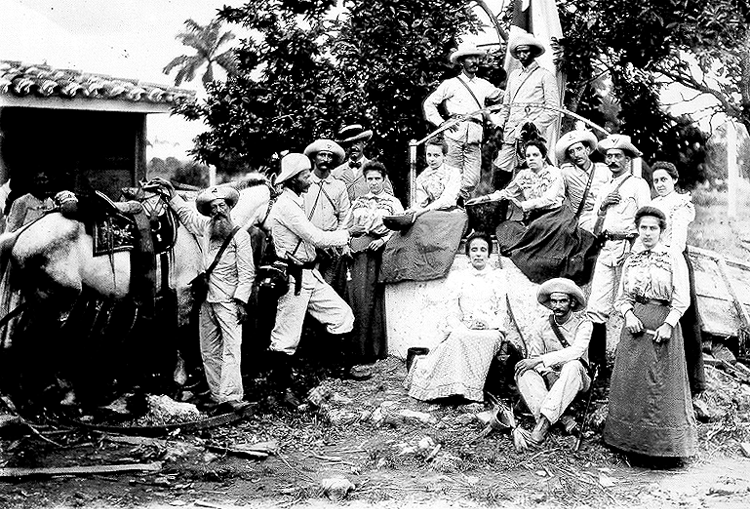 |
|
| 1897 |
1897
|
| January 13 | Spaniards
under General Segura attack General Calixto García at Gabuquito,
and are repulsed with a loss of 300 killed and 400 wounded.
|
| February 4 | Queen
Regent of Spain signed a decree instituting reforms in Cuba.
|
| February 21 | U.S.
Secretary of State Olney directed Minister Taylor, at Madrid, to demand
a full inquiry into the case of Dr. Ricardo Ruiz, who was murdered
in prison, in Guanabacoa, by the Spaniards.
|
| March 4 | General
Valeriano Weyler returned to Havana.
|
| March 21 | Cuban
Insurgents captures Holguin.
|
| March 28 | General
Rius Rivera, who succeeded General Antonio Maceo, is captured with
100 men at Cabezedas by Spanish Colony General Hernández Velasco.
|
| March 30 | Laurada
landed at Banes, on the north coast of Oriente, three dynamite guns,
one Hotchkiss gun and a large quantity of ammunition.
|
| April 17 | General
Valeriano Weyler declares that Santa Clara province and part of Puerto
Principe are pacified.
|
| May 12 | Generals
Calixto García and Rabí defeats Spanish troops under
General Lonos and compels them to retreat on shipboard at Cabo Cruz.
|
| May 17 | President
McKinley sent a message to the US Congress suggesting an appropriation
of $50,000 to relieve the distress of American citizens in Cuba. It
was passed by Congress and signed May 24.
|
| June 21 | General
Valeriano Weyler sails from Havana for Santa Clara province, preceded
by thirty-six battalions of infantry and strong forces of artillery
and cavalry.
|
| June 27 | General
Valeriano Weyler reaches the city of Santiago.
|
| November 10 | Marshal
Ramón Blanco sends a cable to Senor de Lome, Spanish Minister
at Washington, announcing that extensive zones of cultivation have
been marked out, rations issued to the "reconcentrados," and promised
that thereafter they would be fed and treated well
|
| November 14 | General
Blanco sent envoys to insurgent generals to induce them to lay down
their arms.
|
| November 18 | Crew
of the American schooner Competitor captured in 1896 and all sentenced
to
death were released.
|
| November 25 | Dr.
Frank Agramonte, Thomas J. Sainz and other Americans imprisoned in
Havana were released by Marshal Blanco.
|
| November 26 | Queen
Regent of Spain signs royal decrees granting political and commercial
autonomy to Cuba.
|
| December 2 | Bishop
of Havana appeals for food for starving "reconcentrados."
|
| December 9 | Antonio
Rodriguez Rivera, an envoy send by Blanco to bribe the insurgents,
is hanged by the insurgent leader Emilio Collazo.
|
| December 10 | Cuban
insurgents captures Caimanera seaport town.
|
| December 28 | US
President McKinley issues an appeal to the American people to aid starving
Cubans.
|
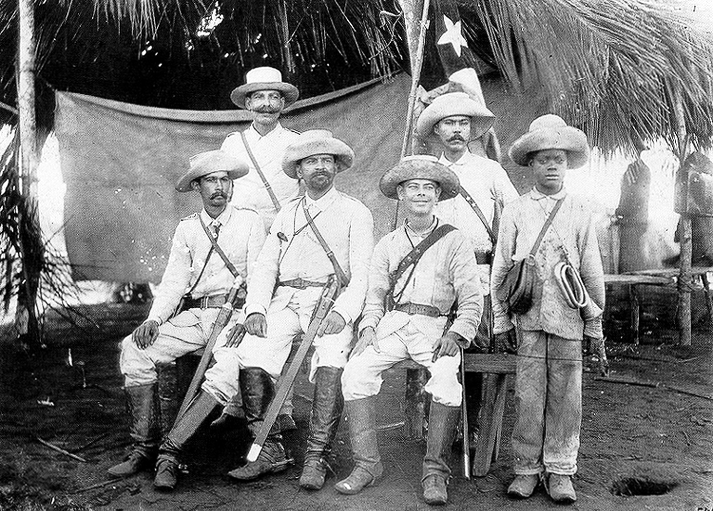 |
|